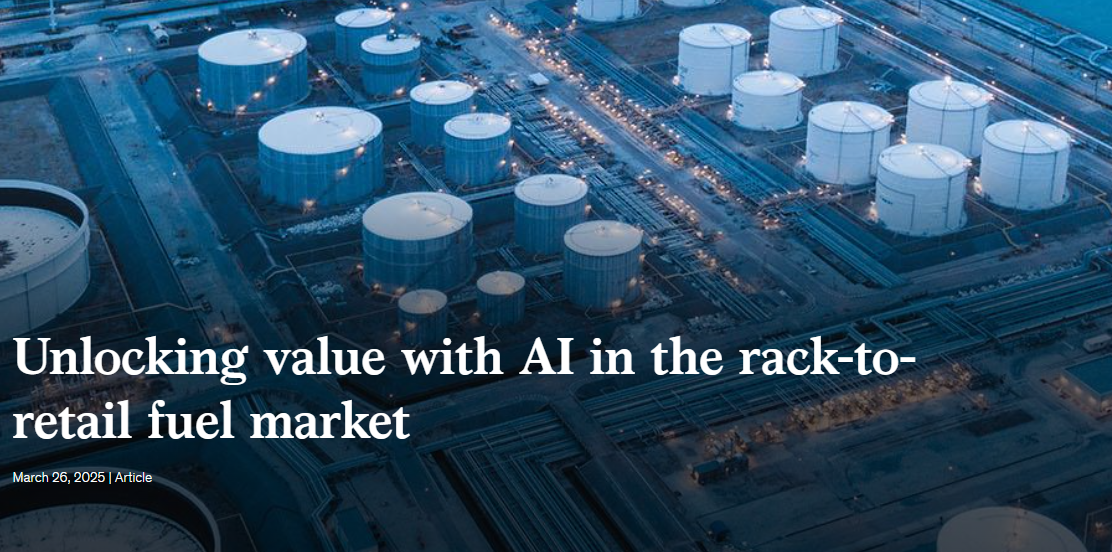Unlocking value with AI in the rack-to-retail fuel market

The downstream wholesale market in the United States is a critical component of the refined fuel supply chain, moving fuel from refineries to end users through pipelines and secondary terminals countrywide (see sidebar “Refinery-to-rack and rack-to-retail: Definitions”).
However, many companies in this sector are grappling with the challenges posed by shifting macroeconomic and geopolitical forces. To thrive in this complex environment, operators need to make integrated, data-driven decisions to capture more value and improve margins.
Achieving this level of integration is not always easy in practice. To remain competitive, companies could overcome operational silos, aggregate reliable data, and embrace AI across functions including supply, pricing, and sales and marketing.
In this article, we examine trends in the rack-to-retail market, highlighting the challenges operators are facing, based on insights from over a dozen industry experts. We also explore how companies could leverage AI solutions to enhance operational efficiency and agility—demonstrating the power of this approach by highlighting localized rack-to-retail fuel transaction patterns and microeconomic market trends (see sidebar “Our methodology”).
Trends and challenges in the US rack-to-retail market
In 2024, the US downstream wholesale market transacted 312 billion gallons of refined fuels through both the refinery-to-rack and rack-to-retail markets (Exhibit 1). Around 77 percent of this was transacted through rack-to-retail, spanning more than 350 rack hubs and covering all five Petroleum Administration for Defense Districts (PADDs).

Fuel from these rack hubs is distributed from more than 1,300 terminals and about 180 suppliers. These terminals predominantly cater to transportation fuels, with refiners and wholesalers operating as the primary suppliers.
The dynamics of the rack-to-retail fuel market can vary significantly between micromarkets (rack hubs), with sudden fluctuations in volume occurring over short periods. The experts we interviewed agree that the market remains opaque, with limited visibility into supply and demand, making it difficult for fuel suppliers and buyers to make informed decisions.
This is problematic, as suppliers need to be able to respond quickly and accurately to market changes to determine the optimal distribution of supply across the rack markets and set appropriate prices. Failing to do so can result in oversupply or stock outs, or lead to poor customer experience. Fuel buyers, meanwhile, face their own difficulties in meeting fuel procurement targets when operating across rack markets. Intraday market volatility impacts which racks can best meet their fuel lifting needs, while optimizing product prices and logistics costs.
Our interviews with industry experts have highlighted challenges facing downstream wholesale market participants on a day-to-day basis, including the lack of market transparency, fragmented data access, significant time and effort spent on manual aggregation of reliable data, and limited AI adoption.
As the industry contends with these challenges, adopting a data-backed approach to tracking trends could equip industry leaders to navigate shifting market conditions and build a foundation for long-term success.
To illustrate the value of this approach, we used AI to analyze the localized macroeconomic market trends and product growth patterns in the rack-to-retail fuel market.
The top 100 rack hubs contribute to the majority of market growth
The volume transacted across US rack hubs varies significantly, ranging from 0.1 billion gallons per year for smaller rack hubs (including Pensacola, Florida, and Dubuque, Iowa) to 6.0 billion gallons per year for larger ones such as Dallas, Texas (Exhibit 2).
The top 100 rack hubs by volume make up approximately 63 percent of the total US rack fuel volume transacted, spanning all five PADDs and representing large metropolitan centers (such as Los Angeles, California) or situated close to refinery distribution points along the pipeline, including Houston, Texas. The average total volume transacted in a top 100 rack hub is 1.5 billion gallons per year. In addition to comprising most of the transacted rack volume, the top 100 hubs contribute the majority of rack market growth—87 percent from 2021 to 2024.
Suppliers closely monitor trends in these “hot spot” micromarkets to optimize their supply chain and margin management.
Product growth varies significantly across rack hubs
Across the top 100 rack hubs, the three major products—regular gasoline, premium gasoline, and ultralow-sulfur diesel (ULSD)—have shown high variances in growth rates, due to macroeconomic dynamics (Exhibit 3).

The median growth rate for regular gasoline, which comprises around 60.0 percent of total fuel volume from the top 100 rack hubs, was 3.1 percent from 2021 to 2024, driving the overall increase in fuel volume. Bainbridge, Georgia and Louisville, Kentucky showed the fastest growth, increasing by 17.8 percent and 16.8 percent, respectively. Colton, California and Corpus Christi, Texas faced the steepest declines, decreasing by 13.9 percent and 9.9 percent, respectively.
Premium gasoline, which represents less than 10 percent of the total volume of the top 100 rack hubs, saw a median growth rate of 2 percent over the same period. The top-quartile growth for premium gasoline was on par with regular gasoline’s median growth, highlighting localized variations in demand. Among the hubs, Niles, Michigan (14.2 percent) and Louisville, Kentucky (14.1 percent) led in growth, while Colton, California (–12.9 percent) and Houston, Texas (–7.6 percent) experienced the largest declines.
ULSD experienced a median growth of 1.5 percent from 2021 to 2024, though growth rates spanned a wider range. Some cities, such as New Orleans, Louisiana and Las Vegas, Nevada, saw dramatic growth in ULSD transactions, with increases of 16.8 percent and 13.9 percent, respectively. On the other hand, cities such as Fresno, California, and Midland/Odessa, Texas experienced declines of –16.3 percent and –15.6 percent, respectively.
These disparities stem from a range of localized factors, including population migration and shifts in income levels, proximity to refineries and pipelines, and even the impacts of extreme weather events on refinery operations—all of which influence regional fuel demand patterns. Proactively managing supply and demand as market dynamics change is critical to maximizing position and margin.
Three strategies downstream companies are utilizing
In a market defined by volatility, market opacity, competition, and the growing need for sustainable practices, operational agility and efficiency can improve the downstream wholesale market’s success.
Through our industry experience, we have observed that companies are streamlining supply chain operations by using integrated solutions to improve efficiency, dismantling silos across functions to allow integrated and real-time decision-making, and embracing predictive analytics to create a competitive advantage.
Integrated and streamlined supply chain: Operational efficiency
Modern supply chains require integration between terminal automation systems and back-office operations, such as enterprise resource planning (ERP) and customer relationship management (CRM) solutions, to ensure real-time data flow and unified operations management. End-to-end automation of supply chain processes from terminal to point of sale can reduce errors and operational delays.
A centralized data hub can play a critical role in consolidating operational, market, and financial data, enabling real-time data access, reducing the need for manual data aggregation, and facilitating data-driven planning and decision execution.
Dismantled silos: Effective decision-making
A cohesive, agile strategy requires cross-functional collaboration and data sharing to ensure alignment around common goals. This can be supported by integrated analytics and reporting using unified data platforms that consolidate information.
Integrated systems allow for aligned sales and pricing strategies, informed marketing decisions, and optimized supply and trading enabled by reliable supply-and-demand forecasts.
Predictive analytics: Competitive advantage
Advances in analytics and AI are revolutionizing supply chain practices, driving automation, and streamlining end-to-end workflows. Companies can now be more responsive and forward-looking, using technologies to:
- provide deep insights into market trends and customer preferences
- forecast demand across regions, fuel types, and grades, and predict supply chain disruptions while recommending preemptive measures
- enhance inventory management and terminal operations, reduce lift times, and improve transportation turnaround
Predictive analytics powered by AI and ML offers transformative potential for demand forecasting, pricing, and inventory optimization by analyzing historical and real-time data. For example, predictive analytics can enhance the accuracy of demand forecasting and improve inventory planning and management by optimizing stock levels and minimizing carrying costs. AI can also sharpen pricing strategies in real time, enabling retailers to adjust to evolving market conditions, competitor actions, and customer behaviors with greater agility. Case studies have shown that suppliers and wholesalers can improve their margin by up to three cents per gallon in select segments through data-driven decision-making by using AI and ML.
To fully capture these benefits, however, companies would need to invest in scalable infrastructure (including integrated back-office operations) and a centralized data repository that ensures access to near-real-time data. In addition, operating model improvement and change management could allow cross-functional teams to collaborate more effectively and make decisions faster. All of this requires leadership commitment, time, and investment.
The downstream fuels industry plays an important role in the broader fuel value chain, yet dynamics within the rack-to-retail segment remain complex and opaque, with notable variations in microlevel rack hub trends.
Given this volatility and uncertainty, players are focusing on driving long-term growth, improving competitive advantage, and enhancing supply chain resilience by adopting integrated, scalable solutions; fostering cross-departmental collaboration; and using predictive analytics for improved forecasting, pricing, and decision-making. These three strategies together could help drive long-term growth in an increasingly dynamic market.

